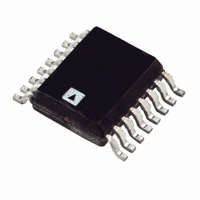ADT7517ARQ Analog Devices Inc, ADT7517ARQ Datasheet - Page 21

ADT7517ARQ
Manufacturer Part Number
ADT7517ARQ
Description
IC TEMP SNSR QUAD DAC 16-QSOP
Manufacturer
Analog Devices Inc
Datasheet
1.ADT7517ARQZ.pdf
(44 pages)
Specifications of ADT7517ARQ
Rohs Status
RoHS non-compliant
Function
Temp Monitoring System (Sensor)
Topology
ADC, Comparator, Multiplexer, Register Bank
Sensor Type
External & Internal
Sensing Temperature
-40°C ~ 120°C, External Sensor
Output Type
I²C™, MICROWIRE™, QSPI™, SPI™
Output Alarm
No
Output Fan
No
Voltage - Supply
2.7 V ~ 5.5 V
Operating Temperature
-40°C ~ 120°C
Mounting Type
Surface Mount
Package / Case
16-QSOP
Available stocks
Company
Part Number
Manufacturer
Quantity
Price
Company:
Part Number:
ADT7517ARQZ
Manufacturer:
Analog Devices Inc
Quantity:
135
DAC Reference Inputs
There is an input reference pin for the DACs. This reference
input is buffered (see Figure 44).
The advantage of the buffered input is the high impedance it
presents to the voltage source driving it. The user can have an
external reference voltage as low as 1 V and as high as V
restriction of 1 V is due to the footroom of the reference buffer.
The LDAC configuration register controls the option to select
between internal and external voltage references. The default
selection is external reference.
Output Amplifier
The output buffer amplifier can generate output voltages to
within 1 mV of either rail. Its actual range depends on the value
of V
If a gain of 1 is selected (Bit 0 to Bit 3 of the DAC configuration
register = 0), the output range is 0.001 V to V
If a gain of 2 is selected (Bit 0 to Bit 3 of the DAC configuration
register = 1), the output range is 0.001 V to 2 V
of clamping, however, the maximum output is limited to
V
The output amplifier can drive a load of 4.7 kΩ to GND or V
in parallel with 200 pF to GND or V
source and sink capabilities of the output amplifier can be seen
in the plot of Figure 18.
The slew rate is 0.7 V/μs with a half-scale settling time to
±0.5 LSB (at 8 bits) of 6 μs.
Thermal Voltage Output
The ADT7516/ADT7517/ADT7519 can output voltages that are
proportional to temperature. DAC A output can be configured
to represent the temperature of the internal sensor and the DAC B
output can be configured to represent the external temperature
sensor. Bit C5 and Bit C6 of the Control Configuration 3 register
select the temperature proportional output voltage. Each time a
temperature measurement is taken, the DAC output is updated.
The output resolution for the ADT7519 is 8 bits with 1°C change
corresponding to 1 LSB change. The output resolution for the
ADT7516 and ADT7517 is capable of 10 bits with 0.25°C change
DD
REF
− 0.001 V.
, gain, and offset error.
OPTIONAL CAPACITOR, UP TO
3nF MAX. CAN BE ADDED TO
IMPROVE HIGH FREQUENCY
NOISE REJECTION IN NOISY
ENVIRONMENTS
TRANSISTOR
SENSING
REMOTE
(2N3906)
DD
(see Figure 5). The
Figure 45. Signal Conditioning for External Diode Temperature Sensor
REF
REF
.
. Because
D+
C1
D–
LOW-PASS
f
C
DD
FILTER
= 65kHz
. The
Rev. B | Page 21 of 44
DD
,
I
DIODE
BIAS
N × I
corresponding to 1 LSB change. The default output resolution
for the ADT7516 and ADT7517 is 8 bits. To increase this to
10 bits, set C1 = 1 in the Control Configuration 3 register. The
default output range is 0 V to V
0 V to 2 V
be done by setting D0 = 1 for DAC A (internal temperature
sensor) and D1 = 1 for DAC B (external temperature sensor) in
the DAC configuration register (Address 0x1B).
The output voltage is capable of tracking a maximum tempera-
ture range of −128°C to +127°C, but the default setting is
−40°C to +127°C. If the output voltage range is 0 V to V
(V
−40°C, and 1.48 V representing +127°C. This, of course, gives
an upper deadband between 1.48 V and V
The internal and external analog temperature offset registers
can be used to vary this upper deadband and, consequently, the
temperature that 0 V corresponds to. Table 6 and Table 7 give
examples of how this is done using a DAC output voltage span
of V
value, in twos complement format, at which 0 V is to start. For
example, if using the DAC A output and 0 V to start at −40°C,
program 0xD8 into the internal analog temperature offset
register (Address 0x21). This is an 8-bit register and has a
temperature offset resolution of only 1°C for all device models.
Use Equation 1 to Equation 4 to determine the value to
program into the offset registers.
Table 6. Thermal Voltage Output (0 V to V
O/P Voltage (V)
0
0.5
1
1.12
1.47
1.5
2
2.25
1
I
Upper deadband has been reached. DAC output is not capable of increasing.
See Figure 41.
BIAS
REF
REF
-IN = 2.25 V), then this corresponds to 0 V representing
and 2 V
V
DD
REF
. Increasing the output voltage span to 2 V
REF
, respectively. Simply write in the temperature
Default °C
−40
+17
+73
+87
+127
UDB
UDB
UDB
ADT7516/ADT7517/ADT7519
1
1
1
TO ADC
V
V
OUT+
OUT–
REF
and this can be increased to
Max °C
−128
−71
−15
−1
+39
+42
+99
+127
REF
.
REF
)
Sample °C
0
+56
+113
+127
UDB
UDB
UDB
UDB
REF
REF
1
1
1
1
can
-IN













